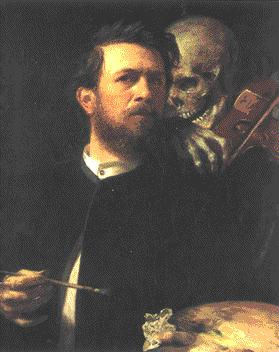Arnold Böcklin was a symbolist Swiss painter. He was disciple of Schirner in Düsseldorf.
He studied in Düsseldorf where he met Ludwig Andreas Feuerbach. At the beginning of his artistic career he depicted mostly landscapes. It was not till he travelled to Belgium, Switzerland and Italy, where he was impregnated with the art from the Renaissance and with the Mediterranean atmosphere, that he began to include mythological and allegorical figures in his works.
Böcklin worked in Basel, Munich and Weimar. In Weimar he was teacher (1860) of landscapes in a new Fine Art School. Later, he moved to Italy and took up residence there (1876). His work Villa by the sea has a better quality than his genre paintings or the ones of historical subject. Having a clear romantic spirit, in addition to his roman tradition, he painted a series of paintings, whose subject is a kind of mythology half pagan, half Germanic. His most outstanding artworks are Spring Day, Centaurs Fighting (Berlin), The Waves (Munich), The Isle of the Dead, Vita Somnium Breve, Paolo and Francesca (Weimar) and Venus Genitrix (Basel).
He belonged to the Art Noveau movement but he was very influenced by Romanticism. His artworks are full of fantastic figures under constructions that come from the classical architecture (and that often reveal an obsession with death), that as a whole depict an odd world of fantasy. That’s why; one of his most famous artworks is The Isle of the Dead, which served as inspiration to several artists as Rachmaninov to create symphonic poems.


